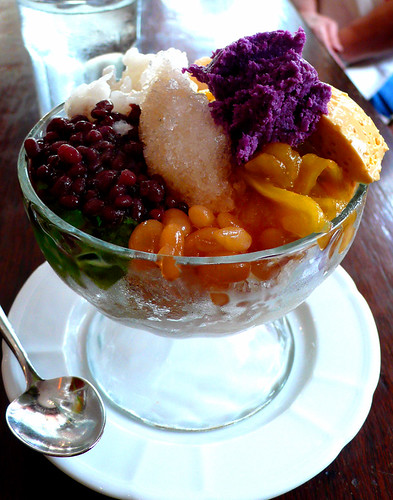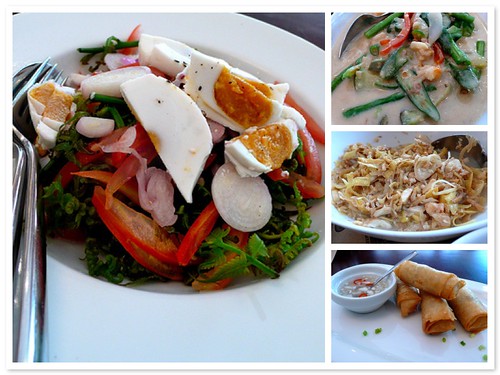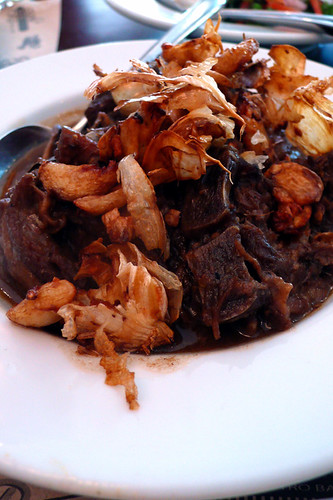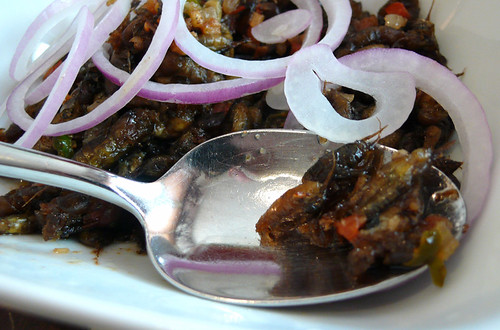typically when we go to the province, there's really not much to do except eat; however, we do that exceptionally well. most of my relatives are very good cooks, and the region we're from, pampanga, is considered the "culinary center of the philippines" (at least according to wiki, ha!). you say chukchak, i say chenes! whether you consider this to be true or not, pampanga has a varied cuisine, mainly due to the fact that in the pre-spanish and early colonial times, pampanga bay used to be a major route for commercial vessels from other countries; as the center of trade, many nationalities would pass through and bring not only their various wares and foodstuff, but their culinary expertise as well. this, along with the abundance of native comestibles from the land and sea created a rich and varied cuisine.
having said all that, it is somewhat surprising to me that there weren't many restaurants that specialized in kapampangan cuisine until recently. even those that did exist were...well, not necessarily bad, but mostly if you wanted to eat kapampangan food, it was better to just get it at home. or a friend's house. so, it was quite nice to find abé (ah-beh) restaurant in the serendra complex at fort bonifacio. not only does it specialize in the provincial cuisine, but it also doesn't suck. huzzah! abé means "friend", so it's like going to your friend's house for a lovely dinner. your friend will a really, really nice house and an incredibly well-stocked pantry, that is. and a full-time staff.
the food is more refined and maybe a little modernized than what you would actually find in the province, but the taste generally remains the same. there is a nice mix of vegetables, seafood, and meat on the menu; there is also a good mix of filipino standards, dishes for people who are trying filipino cuisine for the first time, and those for diners with a more...adventurous palate.
some of my most favourite items on the menu are the vegetables. the pako rainforest fern salad with tomatoes and salted eggs are every-so-lightly dressed in a palm vinegar dressing and garnished with a just as lightly pickled red shallot. crunchy, salty, fresh. the bicol express is a mix of various vegetables--okra, long beans, sweet peppers and chili peppers sautéed with onion and garlic and simmered in coconut milk. the vegetables were just south of al dente, with the tiniest bit of give without being overcooked. bicol express is considered to be a spicy dish, but i have yet to find a restaurant version in the philippines that registers as such to me. adobong puso ng saging is shredded banana blossom stewed in palm vinegar; it tastes not too much unlike a freshly marinated artichoke or a palm heart. the lumpiang picapica is not a regional speciality but a family recipe from the author gilda cordero; it is a fried spring roll with a lightly spiced, cooked garbanzo bean/chickpea filling which, truthfully is a little bland, but not as heavy as one would think. i don't know exactly what flavours it, but i reckon it's a little onion, garlic and turmeric--combined with the vinegar dipping sauce that is sharp with raw garlic and fresh chilis, it makes an interesting appetizer.

the food is more refined and maybe a little modernized than what you would actually find in the province, but the taste generally remains the same. there is a nice mix of vegetables, seafood, and meat on the menu; there is also a good mix of filipino standards, dishes for people who are trying filipino cuisine for the first time, and those for diners with a more...adventurous palate.
some of my most favourite items on the menu are the vegetables. the pako rainforest fern salad with tomatoes and salted eggs are every-so-lightly dressed in a palm vinegar dressing and garnished with a just as lightly pickled red shallot. crunchy, salty, fresh. the bicol express is a mix of various vegetables--okra, long beans, sweet peppers and chili peppers sautéed with onion and garlic and simmered in coconut milk. the vegetables were just south of al dente, with the tiniest bit of give without being overcooked. bicol express is considered to be a spicy dish, but i have yet to find a restaurant version in the philippines that registers as such to me. adobong puso ng saging is shredded banana blossom stewed in palm vinegar; it tastes not too much unlike a freshly marinated artichoke or a palm heart. the lumpiang picapica is not a regional speciality but a family recipe from the author gilda cordero; it is a fried spring roll with a lightly spiced, cooked garbanzo bean/chickpea filling which, truthfully is a little bland, but not as heavy as one would think. i don't know exactly what flavours it, but i reckon it's a little onion, garlic and turmeric--combined with the vinegar dipping sauce that is sharp with raw garlic and fresh chilis, it makes an interesting appetizer.

most of the seafood dishes are very simply prepared: the tiniest of squid (squidlets!) are stewed in its own ink and a little onion and garlic, just enough for it to cook through without losing its tenderness, the hito are baby catfish, fried, and served with fresh mustard greens and balo balo, a condiment made with small shrimp and fermented rice. the pla-pla (a sort of large, flat tilapia) comes simply deep-fried and butterflied. probably the star of the seafood menu is tiger prawns cooked in a deep, earthy, rich sauce made with aligue/taba ng talangka, or the roe and fat from tiny mud crabs. i don't really know how to describe the taste of it, but it's like the perfect cross of caviar and foie gras. rich, fatty, fabulous. the prawns are merely a vehicle for the sauce, although they do provide a nice sweetness.
i like the adobo at abé's a lot; it is made with lamb, stewed in a rich vinegar, garlic and onion sauce, and covered in deep-fried and cracked cloves of garlic. this along with mounds of white rice could sustain me for months. i don't know about my blood pressure, but i'd die happy, i reckon. and thirsty.
the thing is, i could probably make that at home if i thought about it and took a little care. there are a couple of things on the menu that i know i couldn't make, and of these, i give big love to the camaru (káh-mah-roo), or mole crickets (Gryllotalpa orientalis Burmeister). the crickets live in rice paddies and feast on the young grasses and rice husks (okay, okay, and probably the occasional larvae). they are collected from the fields, cleaned, then sautéed with tomatoes, onion, and olive oil. abé's are great because they are still quite small and some unlucky sod in the kitchen has already removed the head, legs and wings--no woody exoskeletons and furry barbed forewings to deal with. heeee.

so, there's definitely room for the adventurous palate here, but should you be looking for a more traditional meal, certainly abé's can accommodate you. it may not quite be like home, but then again, you don't have to do the dishes!
abé
g/f serendra circle,
fort bonifacio, taguig
856.0526.
i like the adobo at abé's a lot; it is made with lamb, stewed in a rich vinegar, garlic and onion sauce, and covered in deep-fried and cracked cloves of garlic. this along with mounds of white rice could sustain me for months. i don't know about my blood pressure, but i'd die happy, i reckon. and thirsty.
the thing is, i could probably make that at home if i thought about it and took a little care. there are a couple of things on the menu that i know i couldn't make, and of these, i give big love to the camaru (káh-mah-roo), or mole crickets (Gryllotalpa orientalis Burmeister). the crickets live in rice paddies and feast on the young grasses and rice husks (okay, okay, and probably the occasional larvae). they are collected from the fields, cleaned, then sautéed with tomatoes, onion, and olive oil. abé's are great because they are still quite small and some unlucky sod in the kitchen has already removed the head, legs and wings--no woody exoskeletons and furry barbed forewings to deal with. heeee.

desserts are quite traditional, so happily, always exoskeleton free (no chance of it, really). i haven't actually tried many of them because there is rarely any room, but i have tried their halo-halo, which tops shaved ice with preserved fruit, ube, sweetened red beans, pandan gulaman gelatin, a creamy chunk of leche flan, and evaporated milk. it is generous in both quality and quantity, which distances it from the middling norm.
abé
g/f serendra circle,
fort bonifacio, taguig
856.0526.







6 comments:
11/18/2007 04:19:00 PM
Beautiful food! No place like home. Everything looks so colorful and yummy.
So how far is this province from the main airport?
11/20/2007 05:11:00 PM
S,
Everything looks so delicious! I'd like some of that halo halo now. Please!
11/20/2007 06:19:00 PM
Yummy..!! i want some dessert..!
11/20/2007 11:35:00 PM
i guess kapampangan region is our country's best gourmet cuisine..im drooling over all those photos..yummy
11/26/2007 12:45:00 AM
happy thanksgiving everyone!
acornbud, it's about an hour away from manila, but it can take an hour to get out of manila....
reid, mamabok, the food here is great!
dhanggit, i would like to think so but i'm biased :)
1/16/2010 11:04:00 PM
Most delicious food in the Philippines are the Capampangan Cuisine.
Post a Comment